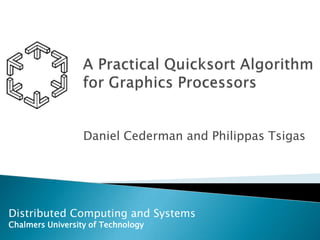GPU-Quicksort
- 1. A Practical Quicksort Algorithmfor Graphics ProcessorsDaniel Cederman and Philippas TsigasDistributed Computing and SystemsChalmers University of Technology
- 4. CPU vs. GPUNormal processorsGraphics processorsMulti-coreLarge cacheFew threadsSpeculative executionMany-coreSmall cacheWide and fast memory busThousands of threads hides memory latency
- 5. Designed for general purpose computationExtensions to C/C++CUDA
- 6. System Model 每 Global MemoryGlobal Memory
- 7. System Model 每 Shared MemoryGlobal MemoryMultiprocessor 0Multiprocessor 1SharedMemorySharedMemory
- 8. System Model 每 Thread BlocksGlobal MemoryMultiprocessor 0Multiprocessor 1Thread Block 0Thread Block 1Thread Block xThread Block ySharedMemorySharedMemory
- 9. Minimal, manual cache32-word SIMD instructionCoalesced memory accessNo block synchronizationExpensive synchronization primitivesChallenges
- 10. System ModelThe AlgorithmExperimentsThe Algorithm
- 11. Quicksort
- 15. Block synchronization on the CPUThread Block 1Thread Block 2
- 16. QuicksortPhase TwoEach block is assigned own sequence
- 17. Run entirely on GPUThread Block 1Thread Block 2
- 18. Quicksort 每 Phase One2 2 0 7 4 9 3 3 3 7 8 4 8 7 2 5 0 7 6 3 4 2 9 8
- 19. Quicksort 每 Phase OneAssign Thread Blocks2 2 0 7 4 9 3 3 3 7 8 4 8 7 2 5 0 7 6 3 4 2 9 8
- 20. Quicksort 每 Phase OneUses an auxiliary arrayIn-place too expensive2 2 0 7 4 9 3 3 3 7 8 4 8 7 2 5 0 7 6 3 4 2 9 8
- 21. Quicksort 每 Synchronization2 2 0 7 4 9 3 3 3 7 8 4 8 7 2 5 0 7 6 3 4 2 9 8LeftPointer = 01Thread Block ONEFetch-And-AddonLeftPointer0Thread BlockTWO
- 22. Quicksort 每 Synchronization22 0 7 4 9 3 3 3 7 8 4 8 7 2 5 0 7 6 3 4 2 9 832LeftPointer = 22Thread Block ONEFetch-And-AddonLeftPointer3Thread BlockTWO
- 23. Quicksort 每 Synchronization220 7 4 9 3 3 3 7 8 4 8 7 2 5 0 7 6 3 4 2 9 83223LeftPointer = 45Thread Block ONEFetch-And-AddonLeftPointer4Thread BlockTWO
- 24. Quicksort 每 Synchronization2 2 0 7 4 9 3 3 3 7 8 48 7 2 5 0 7 6 3 4 2 9 8322330239778785769802LeftPointer = 10
- 25. Quicksort 每 Synchronization2 2 0 7 4 9 3 3 3 7 8 4 8 7 2 5 0 7 6 3 4 2 9 8322330239477878576984402Three way partition
- 26. Two Pass Partitioning2 2 0 7 4 9 3 3 3 7 8 4 8 7 2 5 0 7 6 3 4 2 9 8<<<<<<<<<<===>>>>>>>>>>>===
- 27. Recurse on smallest sequenceMax depth log(n)Explicit stackAlternative sortingBitonic sortSecond Phase
- 28. System ModelThe AlgorithmExperimentsThe Algorithm
- 29. GPU-Quicksort Cederman and Tsigas, ESA08GPUSort Govindaraju et. al., SIGMOD05Radix-Merge Harris et. al., GPU Gems 3 *07Global radix Sengupta et. al., GH07Hybrid Sintorn and Assarsson, GPGPU07Introsort David Musser, Software: Practice and ExperienceSet of Algorithms
- 36. First PhaseAverage of maximum and minimum elementSecond PhaseMedian of first, middle and last elementPivot selection
- 37. 8800GTX16 multiprocessors (128 cores)86.4 GB/s bandwidth8600GTS4 multiprocessors (32 cores)32 GB/s bandwidthCPU-ReferenceAMD Dual-Core Opteron 265 / 1.8 GHzHardware
- 38. 8800GTX 每 Uniform Distribution
- 39. 8800GTX 每 Uniform Distribution
- 40. 8800GTX 每 Uniform 每 16M
- 41. 8800GTX 每 Uniform 每 16MCPU-Reference~4s
- 42. 8800GTX 每 Uniform 每 16MGPUSort andRadix-Merge~1.5s
- 43. 8800GTX 每 Uniform 每 16MGPU-Quicksort~380msGlobal Radix~510ms
- 44. 8800GTX 每 Sorted Distribution
- 45. 8800GTX 每 Sorted Distribution
- 46. 8800GTX 每 Sorted 每 8M
- 47. 8800GTX 每 Sorted 每 8MReference is faster than GPUSort and Radix-Merge
- 48. 8800GTX 每 Sorted 每 8MGPU-Quicksorttakes less than200ms
- 49. 8800GTX 每 Zero Distribution
- 50. 8800GTX 每 Zero Distribution
- 51. 8800GTX 每 Zero 每 16M
- 52. 8800GTX 每 Zero 每 16MBitonic is unaffected by distribution
- 53. 8800GTX 每 Zero 每 16MThree-way partition
- 54. 8600GTS 每 Uniform Distribution
- 55. 8600GTS 每 Uniform Distribution
- 56. 8600GTS 每 Uniform 每 8M
- 57. 8600GTS 每 Uniform 每 8MReference equal to Radix-Merge
- 58. 8600GTS 每 Uniform 每 8MQuicksort and hybrid ~4 times faster
- 59. 8600GTS 每 Sorted Distribution
- 60. 8600GTS 每 Sorted Distribution
- 61. 8600GTS 每 Sorted 每 8M
- 62. 8600GTS 每 Sorted 每 8MHybrid needs randomization
- 63. 8600GTS 每 Sorted 每 8MReference better
- 64. Visibility Ordering 每 8800GTX
- 65. Visibility Ordering 每 8800GTXSimilar to uniform distribution
- 66. Visibility Ordering 每 8800GTXSequence needs to be a power of two in length
- 67. Minimal, manual cacheUsed only for prefix sum and bitonic32-word SIMD instructionMain part executes same instructionsCoalesced memory accessAll reads coalescedNo block synchronizationOnly required in first phaseExpensive synchronization primitivesTwo passes amortizes costConclusions
- 68. Quicksort is a viable sorting method for graphics processors and can be implemented in a data parallel wayIt is competitiveConclusions


































































